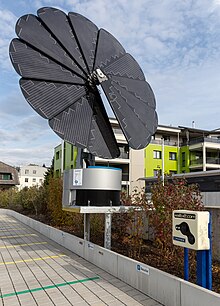Solar filling station
A solar filling station is a charging station for charging electric vehicles , in which the electrical energy is obtained from solar energy . This is mostly done through solar cells installed on the roof of the petrol station building or in the vicinity on other roofs or suitable substructures .
In the context of the energy transition in traffic, solar filling stations are an element of decentralized power generation .
Electricity generated by the solar charging station, which is not used directly to charge the vehicle, is mostly fed into the electricity grid. Conversely, energy can also be taken from the power grid to charge vehicles. Very few solar filling stations use their own solar batteries . The accumulators cannot be operated economically when connected to the mains. In the future, however, their use may represent an option to keep the grid connection capacity within limits, especially against the background of short charging times in the minutes range and the high outputs required for this in the two- and three-digit kilowatt range.
The balance sheet of a solar filling station should be at least balanced, if not even show a surplus. Otherwise, the operation is grid-dependent with solar support. Electric cars need between around 8 and 25 kWh for a distance of 100 km. A Danish study names 18.3 kWh per 100 km as the average value under realistic conditions. With an annual mileage of 15,000 km, that is between 1200 and 3750 kWh / a. These amounts of energy can be generated with solar systems that require less than the area of the roof of a single-family house.
If several vehicles are charged daily at a grid-connected solar filling station, where there is not significantly more than 20 m² of solar module area available per parking space, it must be assumed that the energy drawn from the grid is only offset to a small extent by the solar energy fed in. In this case it is a normal charging station that is only supported by solar energy.
The first solar filling station was opened in Austria in 2000. In Switzerland, the first solar filling stations were used from around 1986 for the Tour de Sol solar rally , on the one hand to allow production vehicles that could not achieve the required performance with only solar cells on the vehicle, and on the other hand to use the rather expensive solar cells more effectively outside of the event.
A solar filling station was offered in addition to the Tesla Roadster or the Twike . Independent providers are also represented on the market. The design of the solar carport increases the solar coverage of the electricity requirement and uses the parking space at the same time.
Solar filling stations are sometimes also used in electric boats . There, especially with pleasure boats, a large proportion of the electricity can be used directly for charging due to the long lay times. They often generate a significant surplus of electrical energy that is fed into the power grid, provided they are connected to it.
In Germany, the Federal Association of Solar Mobility advocates mobility using solar energy.
Web links
Individual evidence
- ↑ Gebeyehu M. Fetene, Sigal Kaplan, Stefan L. Mabit, Anders F. Jensen, Carlo G. Prato: Harnessing Big Data for Estimating the Energy Consumption and Driving Range of Electric Vehicles. Technical University of Denmark, 2016, accessed November 10, 2017 .
- ↑ Solar filling station
- ↑ http://www.pressetext.de/pte.mc?pte=000926010 ( page no longer available , search in web archives ) Info: The link was automatically marked as defective. Please check the link according to the instructions and then remove this notice.
- ↑ autobloggreen: Exclusive Q & A with Elon Musk on the Tesla Roadster and the future of EVs (English)
- ↑ http://www.solarmobil.net/mobility.htm


